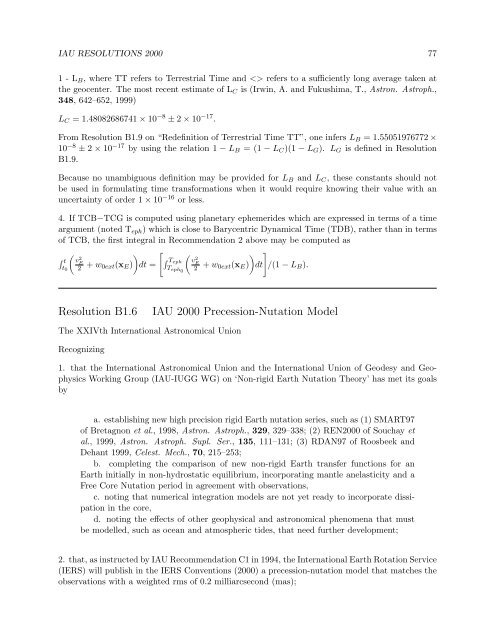USNO Circular 179 - U.S. Naval Observatory
USNO Circular 179 - U.S. Naval Observatory
USNO Circular 179 - U.S. Naval Observatory
You also want an ePaper? Increase the reach of your titles
YUMPU automatically turns print PDFs into web optimized ePapers that Google loves.
IAU RESOLUTIONS 2000 77<br />
1 - LB, where TT refers to Terrestrial Time and refers to a sufficiently long average taken at<br />
the geocenter. The most recent estimate of LC is (Irwin, A. and Fukushima, T., Astron. Astroph.,<br />
348, 642–652, 1999)<br />
LC = 1.48082686741 × 10 −8 ± 2 × 10 −17 .<br />
From Resolution B1.9 on “Redefinition of Terrestrial Time TT”, one infers LB = 1.55051976772 ×<br />
10 −8 ± 2 × 10 −17 by using the relation 1 − LB = (1 − LC)(1 − LG). LG is defined in Resolution<br />
B1.9.<br />
Because no unambiguous definition may be provided for LB and LC, these constants should not<br />
be used in formulating time transformations when it would require knowing their value with an<br />
uncertainty of order 1 × 10 −16 or less.<br />
4. If TCB−TCG is computed using planetary ephemerides which are expressed in terms of a time<br />
argument (noted Teph) which is close to Barycentric Dynamical Time (TDB), rather than in terms<br />
of TCB, the first integral in Recommendation 2 above may be computed as<br />
<br />
Teph<br />
<br />
t v2 E<br />
t0 2 + w0ext(xE) dt =<br />
Teph 0<br />
v 2 E<br />
2<br />
<br />
+ w0ext(xE) dt<br />
/(1 − LB).<br />
Resolution B1.6 IAU 2000 Precession-Nutation Model<br />
The XXIVth International Astronomical Union<br />
Recognizing<br />
1. that the International Astronomical Union and the International Union of Geodesy and Geophysics<br />
Working Group (IAU-IUGG WG) on ‘Non-rigid Earth Nutation Theory’ has met its goals<br />
by<br />
a. establishing new high precision rigid Earth nutation series, such as (1) SMART97<br />
of Bretagnon et al., 1998, Astron. Astroph., 329, 329–338; (2) REN2000 of Souchay et<br />
al., 1999, Astron. Astroph. Supl. Ser., 135, 111–131; (3) RDAN97 of Roosbeek and<br />
Dehant 1999, Celest. Mech., 70, 215–253;<br />
b. completing the comparison of new non-rigid Earth transfer functions for an<br />
Earth initially in non-hydrostatic equilibrium, incorporating mantle anelasticity and a<br />
Free Core Nutation period in agreement with observations,<br />
c. noting that numerical integration models are not yet ready to incorporate dissipation<br />
in the core,<br />
d. noting the effects of other geophysical and astronomical phenomena that must<br />
be modelled, such as ocean and atmospheric tides, that need further development;<br />
2. that, as instructed by IAU Recommendation C1 in 1994, the International Earth Rotation Service<br />
(IERS) will publish in the IERS Conventions (2000) a precession-nutation model that matches the<br />
observations with a weighted rms of 0.2 milliarcsecond (mas);


